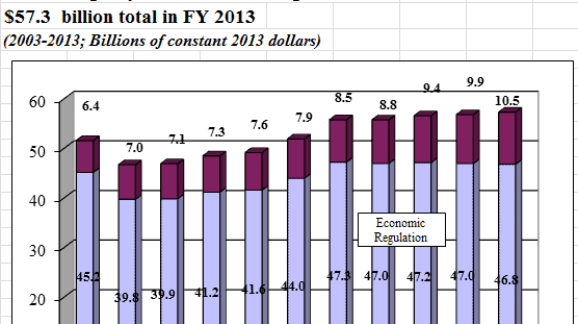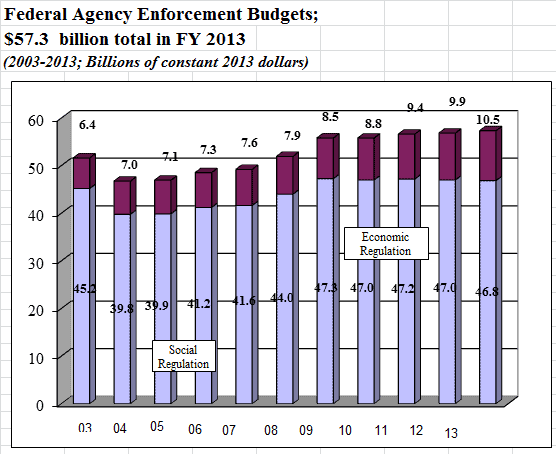Red Tapeworm 2014: The High Cost of Overcriminalization

This is Part 8 of a series taking a walk through some sections of Ten Thousand Commandments: An Annual Snapshot of the Federal Regulatory State (2014 Edition)
Regulatory cost estimates encompass compliance costs and economic impacts affecting the public, but those estimates do not include administrative costs—the on-budget amounts spent by federal agencies to produce rules and to police and enforce them.
In their annual Regulators’ Budget series, Melinda Warren of the Weidenbaum Center at Washington University in St. Louis and Susan Dudley of the Regulatory Studies Center at George Washington University in Washington, D.C., examine the president’s annual federal budget proposal to compile the administrative costs of developing and enforcing regulations.
Unlike regulatory compliance costs and economic effects, these amounts are disclosed in the federal budget, because those are funds that taxpayers pay to support agencies’ administrative budgets.
A lot is spent to collect fines, deny permits, and pursue alleged violators of regulations. Overcriminalization results.
The estimated FY 2013 enforcement costs incurred by federal departments and agencies stood at an estimated $57.3 billion (in constant 2013 dollars, adjusted from origninal 2005 dollars), a slight 0.86 percent increase over $56.8 billion the previous year.

Of that amount, $10.5 billion was spent administering economic regulations. The larger amount spent for writing and enforcing social and environmental regulations was $46.8 billion.
The Environmental Protection Agency alone spent an estimated $5.5 billion in 2013, accounting for 9.6 percent of the total expected to be spent by all regulatory agencies. The EPA used to account for the lion’s share of rules promulgated, but now the newer Department of Homeland Security, at an estimated $23.7 billion, accounts for 41 percent, approaching half.
That $57.3 billion in agency costs helps complete a picture of the federal regulatory apparatus. Adding these administrative costs tabulated by the Weidenbaum Center and the Regulatory Studies Center to the $1.863 trillion Tip of the Costberg placeholder for compliance and economic costs brings the total estimated 2013 regulatory burden to about $1.92 trillion.
Estimated full-time-equivalent employment staffing reached 282,070 in FY 2013, according to the Regulators’ Budet report—nearly 100,000 more than just over a decade ago (185,205 in 2002). Much of the post-2002 surge apparent in their data may be largely attributable to the newly created Transportation Security Administration’s hiring of thousands of airport screening personnel. Over the past year, overall staffing is up 1.6 percent (from 277,549).